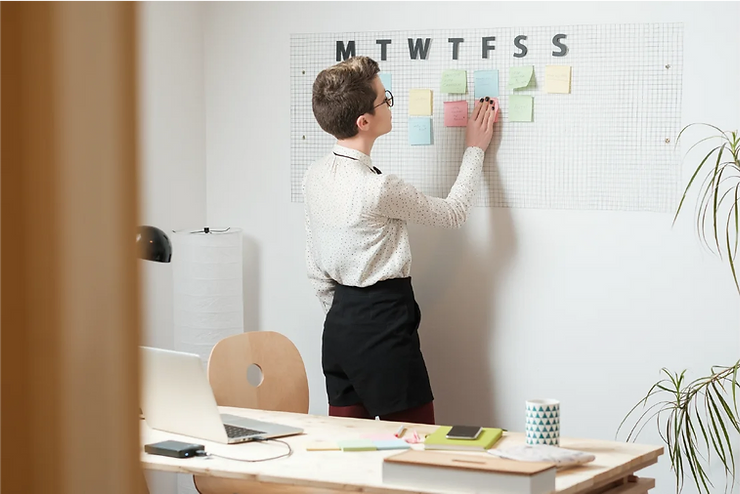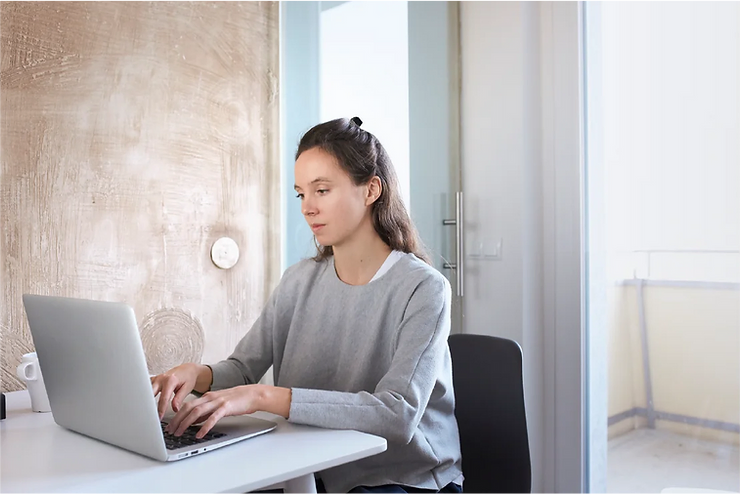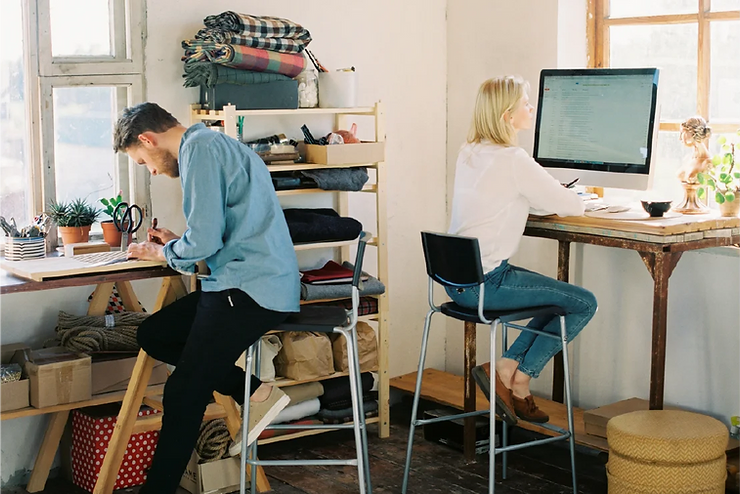
I started working full-time when I was 19, first as a marketing associate and then as a product manager when I transferred departments. Getting to work on a product I believed in with a fun and talented team was very fulfilling, and I enjoyed my time there a lot, but I found myself completely drained every day when I got home.
There were a lot of things that made working full-time difficult for me. My sleeping disorder impeded my ability to get up on time every day, and I would often have to stay a little later to make up for sleeping in. I also had no time for creative projects and found it difficult to focus on work for hours and hours at a time.
I started fantasizing about what it would be like to work from home and sleep in, take breaks to watch TV, and do things on my own time.
Despite my self-employment ambitions, I took another full-time position when I moved to New York, so that I could pay rent. I would think and talk a lot about becoming a freelancer, but I was terrified that I wouldn’t find any work if I left my job to freelance.
Getting laid off was the straw that broke the camel’s back. Suddenly, I had no job to fall back on and no safety net. I had never freelanced before, but I promised myself I’d never work full-time again.
Over that next year, I worked hard at finding new clients, branding myself, and finding a balance of life and work that made sense for me. Here’s what I learned.
How to become a freelance UX designer
5. Invoicing
01. Build up your portfolio
This is the first thing that a prospective client will look at. If your portfolio is lackluster, they likely won’t bother looking at your CV or your work history. If you’re not happy with your portfolio, take the time to make new things to add to it or create a new portfolio.
02. Invest in LinkedIn
A lot of people looking to hire on freelance sites will want to see your LinkedIn profile to get a better sense of who you are and the environments you’ve worked in. Flesh out your previous roles and make sure you’re highlighting the accomplishments you’re most proud of. Ask your former (or current) coworkers to endorse you and write a review. They go a long way.
03. Make a website
You should have a professional website featuring your work. Make sure to add a “Hire” or “Contact” option to prompt or persuade leads into taking action. This will generate more traffic for your business and give you a calling card you can use for interested clients or people you meet by chance outside work hours (this has happened to me multiple times). Learn more about how to make a website or create a freelance website.
04. Contracts, contracts, contracts
Before you start a job, always make sure you have a contract in place to protect yourself in the hopefully unlikely event of any disputes. If you’re working through a freelancing site, they will have those in place for you. Sometimes clients have contracts as well, which you should read as thoroughly as possible. If you need a contract, Jyssica Schwartz was kind enough to create a great template you can use.
05. Invoicing
Again, freelancing sites and clients sometimes take care of this, but you should look into your options and your local laws regarding payment and protections for freelancers. Generate invoices with Wix.
06. Bring your personality
One of the most important qualities in a freelancer is personality. Your attitude, insight, kindness, and optimism will go further than you think in your relationships with clients. Being good at your job will get you gigs. Being a pleasure to work with will help you keep them. The combination of both hard and soft skills will take you far when it comes to starting a business.

UX freelance designer tips
Getting work is hard, but not impossible
Before officially becoming a freelancer, I had eyed freelance job postings occasionally. I noticed that in the full-time job market, companies tend to look for UX designers, whereas in the freelancing world, clients were mostly looking for one person to work on both UI and UX.
Having worked with UI designers in what was essentially an unofficial art director position for six years, I had already started dabbling in UI, but, when I decided to become a freelancer, I bit the bullet and invested in a graphic design course. While looking for work, I also continued practicing my UI design skills by doing the DailyUI Challenge and getting involved with the design community on Dribbble.
Since I wouldn’t be able to share specs I wrote for my previous jobs, I made up an app for which I wrote a job application-friendly dummy specification document detailing its functionality.
I checked a few different freelancing sites, but the clear choice for me was Upwork. They tend to list longer term jobs and have higher quality clients, unlike other sites that focus more on one-off projects and attract lower paying clients due to their branding and business model.
The great thing about freelancing sites is that they list your profile and help clients find you for free, but the trade-off is that they will take a cut of your income for using their platform. While their fee may be a turn off, it’s worth noting that they provide other services that can make it worthwhile; while freelancing on your own can lead to contentious disagreements with clients, Upwork has hour tracking and mediation in place. Upwork also uses an automatic billing system that makes sure you get paid on time and verifies prospective clients’ ability to pay you.
The catch-22 I found myself in when getting started on Upwork was that it was extremely difficult to get work because I didn’t have any logged hours or reviews on my profile, but I couldn’t get reviews or log hours without getting work.
After a few weeks of applying to jobs with no traction, I decided that I would need to become much more competitive to get my first job, which would mean temporarily lowering my freelance design rate. I started sorting posts by number of proposals, so that I’d only focus on projects with fewer submissions that other designers with more work experience weren’t applying to.
I had been on the hiring end of Upwork for previous jobs, so I knew what it looked like to receive submissions and what stood out to me. A lot of freelancers don’t invest in a cover letter (no one likes writing them, but they do make a difference), so I knew that, by putting some effort into mine, I’d stand out.
I always used optimistic language, even going so far as to sign off every letter with “Looking forward to working with you!” While somewhat presumptuous, it made me seem excited and ready to get started. I would also try to pick out parts of the job that I have experience with and explain my expertise and why I’d be a good fit.
After a lot of submissions and cover letters, I finally managed to secure my first gig at my lower rate. I made sure to work fast and communicate often and clearly–two important things to do while freelancing. After having a completed gig and a positive rating under my belt, I was able to raise my price to the hourly rate I wanted. While jobs were still hard to get, my win rate started increasing, and, after a few months, I was able to find my first long-term client.

As a freelancer, nothing is guaranteed. Hang on to your long-term clients and work hard, but, remember, you’re not an employee, and they can stop working with you at any time with no notice.
Work isn’t reliable
I learned the hard way that nothing is guaranteed as a freelancer. After close to half a year of working with my first ongoing client, they had to stop working with me due to budget constraints. (I’ve since started working with them again–always stay on good terms with clients!) I was dealt a major blow because I wasn’t prepared for this significant change in income from what I’d assumed was going to be an ongoing client for the foreseeable future.
This was my first hard-learned lesson as a freelancer. Nothing is guaranteed. Hang on to your long-term clients and work hard, but, remember, you’re not an employee, and they can stop working with you at any time with no notice.
It took a few more months of scrambling and digging into my savings before I found another long-term client.
Here’s freelancing lesson number two. Be ready financially. I’m incredibly privileged not to have any debt and to have saved up from working full-time for six years. If I wasn’t in this position, the months with little income would have been devastating. If you want to freelance, it’s absolutely critical that you have money saved up in order to weather the ebbs and flows of incoming work.
Searching for gigs when you’re not making money is hard because you’re at the mercy of whatever that comes along. I’m certainly not going to tell you to turn down work if you need it, but if you want to find a long-term gig, make sure you’re in a position to accept it when the opportunity presents itself.
There was more than one occasion where I was bouncing between several small gigs and was unable to take a job that would require more of my time. I always make sure to see projects through and to ensure my clients are happy with my work, even when it may be more advantageous to jump ship in favor of another project.
For the third freelancing lesson, remember that your reputation is everything. Especially when using a freelancing site, new clients are looking at your reviews and your portfolio more than your resume. Most of the work I’ve gotten since that first gig has been because of positive reviews–Upwork even has a “Top Rated” status for users with 100% job success that boosts your profile visibility. Investing in your clients should be a no-brainer, but it pays off, too.
Another thing to keep in mind is that you can be paid hourly or on a project basis. From my experience, working on a per-project basis is often not worth doing unless it’s meticulously defined, as misunderstandings are common, and you might end up doing more work than you had planned. This results in scope creep. Sticking to working on an hourly basis ensures you’ll get paid the amount you expect for the time you put in and will spare you from misaligned expectations.

Work-life balance
Working from home can be difficult. It requires a lot of self-discipline to constantly search for new work and accomplish tasks when you don’t have a supervisor looking over your shoulder. Figuring out what works for you–how many hours you want to work, when you work, and when you don’t–can be a bit of a trial-and-error process. Picking up a lot of projects can mean you work more hours than you’d like, and having deadlines you need to meet can make you pick up work at strange hours of the day (or night).
Every freelancer has different wants and needs, but I found that it was important to create boundaries for work hours. I go through the different tasks I need to complete, and, when I finish, I log off for the day. If I get an email from a client once my “work time” is over, I set it aside and look at it the next day. When you set your hours, it’s crucial to have a hard stop so you can relax. Otherwise, you’re always working. I also have different users in Chrome for my personal browsing and my work, so I don’t have to see work-related content when I’m not working.
Sometimes having several projects going at the same time with strict deadlines or client expectations can be daunting, and sometimes it’s tempting to work non-stop to get them done. But remember that there are only so many hours a day you can actually be productive. Working too long will affect the quality of your work.
Use white boards, sticky notes, task management software–whatever you have at your disposal–and map out everything you need to do, so you have it written down. Work backwards from your deadlines and figure out where you need to work on what project in order to meet them. Sometimes, we have a lot of balls up in the air, and just writing it all out can help organize it in our minds. Once you see the hours you need to put into each project, you can budget your time, so you don’t overwork yourself. If necessary, pencil in your relaxation time, as well.
That being said, I do glance at work emails and texts after hours just to make sure there’s nothing urgent that needs to be addressed because it’s still important to tend to client needs. If it can wait, I’ll put my phone back down. If it can’t, I can subtract the time I put in from my next work day (if possible) and have a longer break.
Working from home can also be lonely and a little claustrophobic. When you don’t have to go to an office, your exposure to friends–or just people, in general–is very limited. I’m lucky to have a roommate that also works from home, so the apartment is never empty, which is helpful.
When it’s safe to do so again, creating a space for other friends who work from home can make you much more productive. Also, getting out of the house and working from a cafe or a park can be a welcome change of scenery when you’re feeling cooped up.
